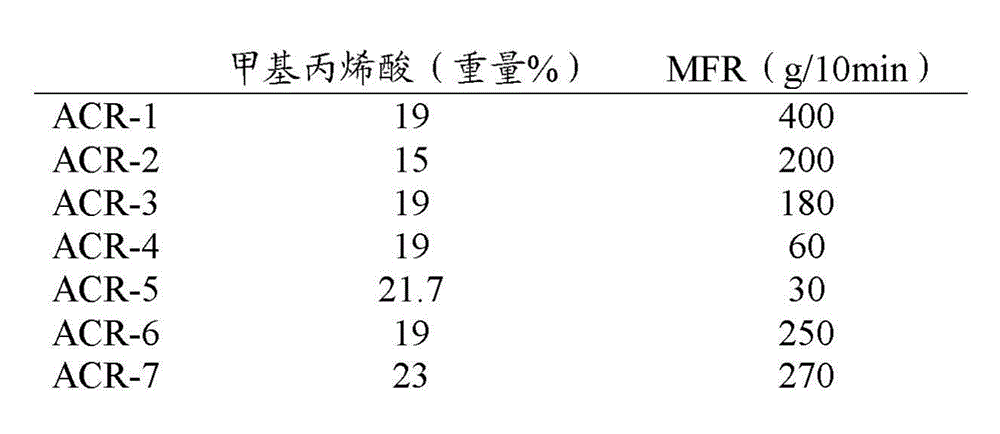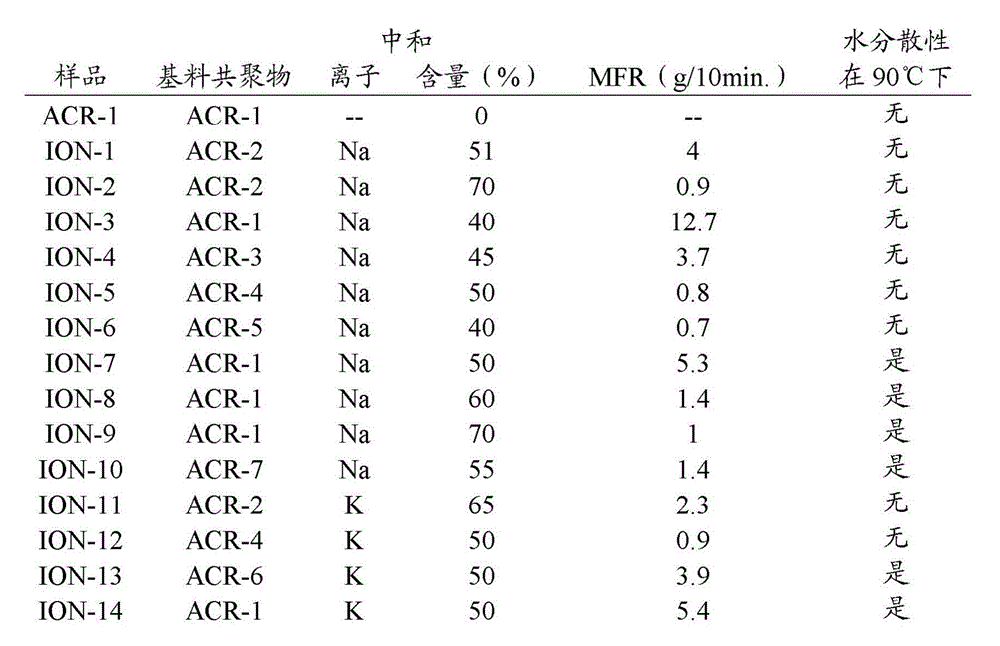High viscosity blends and coatings of an ionomer and poly(vinyl alcohol)
A technology of ionomer and vinyl alcohol, applied in the field of blending compositions, can solve the problems of complex ionomer dispersion process and the like
- Summary
- Abstract
- Description
- Claims
- Application Information
AI Technical Summary
Problems solved by technology
Method used
Image
Examples
example
[0176] Table 1 summarizes the ethylene-methacrylic acid dimers used to prepare the ionomers in Table 2 having the indicated weight % of methacrylic acid interpolymerized units based on the total acid copolymer. Ionomers were prepared from acid copolymers using standard conditions. Melt flow rate (MFR) was determined according to ASTM D1238 at 190°C using a 2160 g load; a similar test is ISO 1133.
[0177] Table 1
[0178]
[0179] ionomer
[0180] Table 2 summarizes the ionomers derived from ethylene methacrylic acid dimer, showing the percentage of carboxylic acid groups neutralized with sodium hydroxide to form the sodium salt or with potassium carbonate to form the potassium salt. Water dispersibility is determined according to the following method, which exemplifies the addition of unneutralized acid copolymers or ionomers to hot water. The process yields a mixture of water and a 10% solids loading by weight (weighed before adding to the water). Add 500 mL of di...
example 1-12 and comparative example C2-C19
[0185] These examples illustrate a method of mixing a preformed aqueous PVOH solution with a preformed aqueous ionomer dispersion. An 11.6 wt% aqueous dispersion of ION-8 was prepared by suspending the solid material in hot (90 to 95°C) water and stirring until all solid material disappeared. The ionomer dispersion is a translucent milky liquid.
[0186] Poly(vinyl alcohol) (PVOH) composition samples are available under the trade name Commercially available from DuPont. Aqueous solutions of the PVOH materials in Table 3 were prepared by suspending the solid material in cold water, then heating to 90 to 95°C with stirring until all solid material disappeared. The poly(vinyl alcohol) solution is a clear and transparent solution.
[0187] table 3
[0188]
[0189] Blends of aqueous ionomer dispersions and aqueous poly(vinyl alcohol) solutions were formulated by mixing them together at room temperature to produce the blend compositions summarized in Table 4. Specificall...
example 13
[0212] This example shows an embodiment where a solid ionomer composition is contacted with an aqueous solution of PVOH. Two grams of PVOH-6 were stirred in 180 grams of water at a temperature of 23°C. The resulting mixture was heated to a temperature of 39° C. within 13 minutes, forming a clear aqueous solution. Heating was continued until the solution reached a temperature of 96°C within 15 minutes, and 9 grams of ION-8 in the form of fused-cut pellets were added with stirring. Within 2 minutes, ION-8 had been completely dispersed in water, and an additional 9 grams of fused-cut pellets were added. ION-8 in pelletized form. Within 17 minutes all of the ION-8 added had been completely dispersed in the water and the heat was turned off.
[0213] The following examples demonstrate coated paperboard with aqueous dispersions. Aqueous ionomers were prepared by mixing 10% by weight of PVOH-6 in water with 10% by weight of ION-2 Thing-PVOH dispersion. Similarly, comparative exam...
PUM
| Property | Measurement | Unit |
|---|---|---|
| melt flow index | aaaaa | aaaaa |
| thickness | aaaaa | aaaaa |
| thickness | aaaaa | aaaaa |
Abstract
Description
Claims
Application Information
 Login to View More
Login to View More - R&D
- Intellectual Property
- Life Sciences
- Materials
- Tech Scout
- Unparalleled Data Quality
- Higher Quality Content
- 60% Fewer Hallucinations
Browse by: Latest US Patents, China's latest patents, Technical Efficacy Thesaurus, Application Domain, Technology Topic, Popular Technical Reports.
© 2025 PatSnap. All rights reserved.Legal|Privacy policy|Modern Slavery Act Transparency Statement|Sitemap|About US| Contact US: help@patsnap.com



